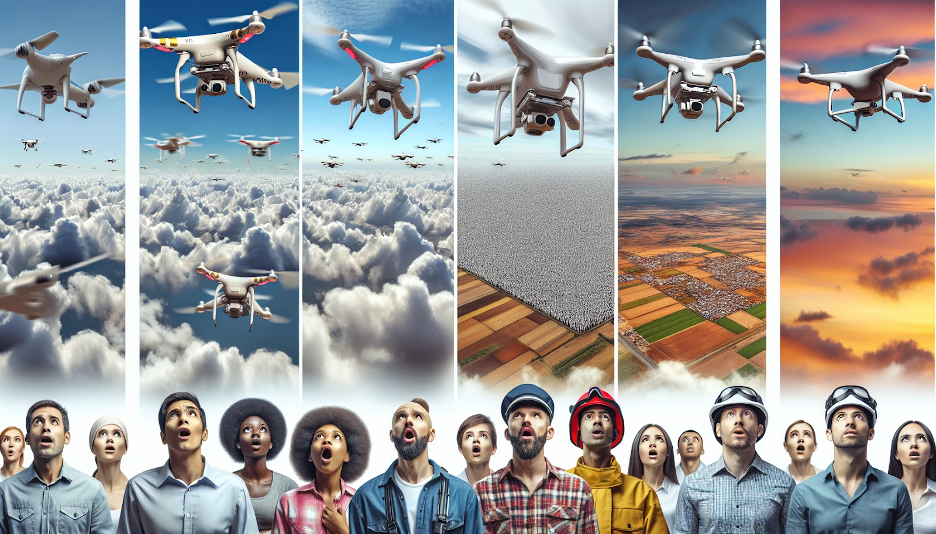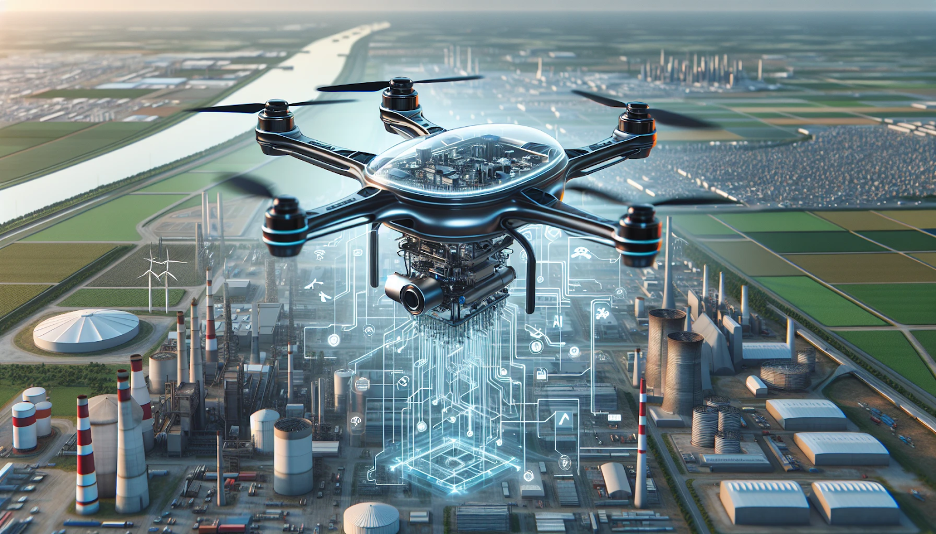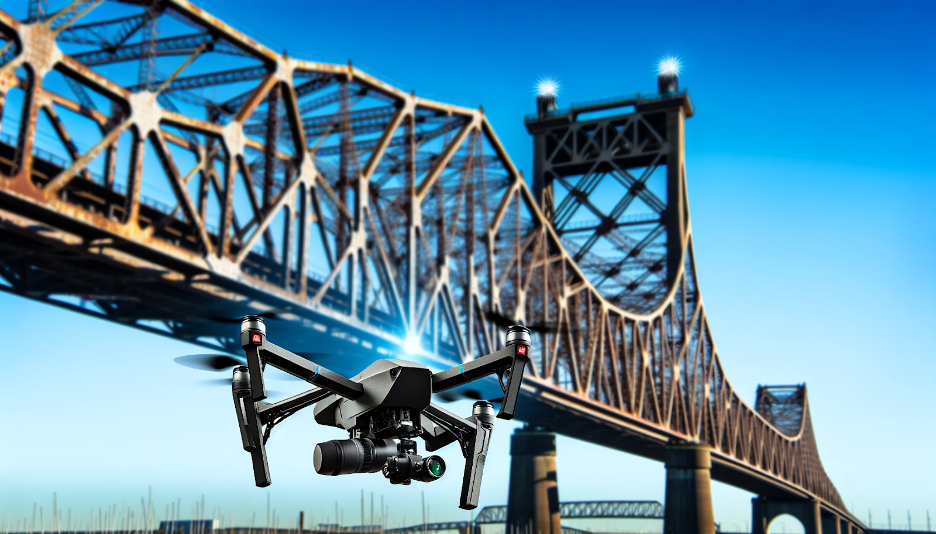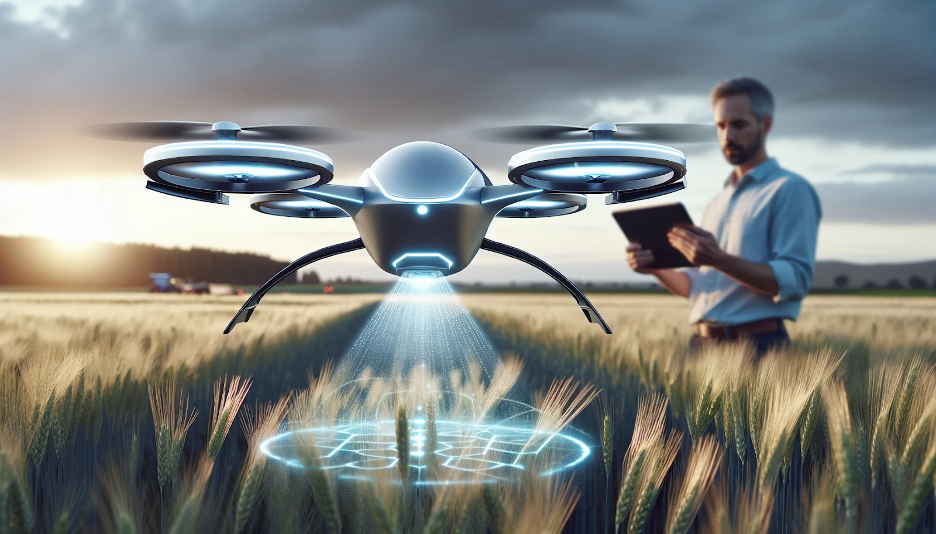By Sunita Arnold, Dec 11, 2023

Ready to soar into the world of drone investments? As this sector experiences unprecedented growth, we invite you to join us on a comprehensive exploration of autonomous drone investing. This guide is not only your gateway to understanding the industry’s expansion and investment mechanics, but also a prime resource on how to invest in drones effectively. Delve into the intricacies of the market landscape and the cutting-edge technologies leading this rapidly evolving market. Our insights will equip you with the knowledge to navigate the vibrant and innovative world of drone investments, ensuring you are well-prepared to capitalize on its growth potential.
Table of Contents
The concept of drones, or unmanned aerial vehicles (UAVs), originated in military applications, primarily for reconnaissance and surveillance missions. These early drones were used as early as World War I for gathering intelligence and were further developed during World War II and the Cold War era for more advanced military operations. They served as important assets in gathering information from enemy territories without risking human lives.
Post the Cold War, technological advancements significantly transformed drones. The 1990s and early 2000s saw a rapid evolution in drone technology, leading to more compact, efficient, and capable UAVs. Military drones like the Predator drone became a staple in modern warfare, capable of both surveillance and offensive operations.
The transition of drone technology from exclusively military to civilian applications marked a pivotal point in the history of UAVs. This shift was fueled by the miniaturization of technology and the increasing affordability of drones. Today, drones are widely used in various civilian sectors, including agriculture, real estate, environmental monitoring, and entertainment.
In the commercial sector, drones have been adopted for tasks such as aerial photography, surveying, and delivery services. Companies like Amazon and UPS are exploring drone delivery systems to revolutionize logistics. Additionally, drones have become popular in recreational use, with enthusiasts and hobbyists utilizing them for photography, racing, and personal enjoyment.
As drones became more accessible, regulatory frameworks evolved to ensure safe and responsible usage. Bodies like the Federal Aviation Administration (FAA) in the United States and the European Aviation Safety Agency (EASA) in Europe have established guidelines for drone operations. Looking forward, the drone industry is poised for further growth, with emerging applications in urban mobility, such as drone taxis, and continued innovation in both commercial and recreational arenas.
The impact of drones extends beyond their specific applications. They have transformed industries, created new job opportunities, and raised important discussions on privacy and security. As the technology continues to evolve, drones are expected to play an increasingly significant role in shaping our future, offering exciting opportunities for investment and innovation.
The drone industry is rapidly expanding, with a projected market value of $50 billion by 2025. With applications in various industries such as agriculture, construction, and logistics, drone technology is revolutionizing the way we work and live. From aerial photography and videography to disaster management and delivery services, commercial drones are transforming industries and creating new investment opportunities.
Technological advancements, increasing commercial adoption, and supportive regulatory frameworks are driving the growth of the drone technology market. Keeping abreast with emerging trends and developments becomes pivotal as the market continues to grow, aiding in making informed investment decisions. So, buckle up and get ready to explore the exciting world of autonomous drones!

Investing in drone technology presents three main avenues: private company stocks, direct investment in drone manufacturers or placing your funds in ETFs and mutual funds focused on unmanned aerial vehicles (UAVs). Each approach offers unique opportunities and challenges, so let’s dive deeper to help you decide which path best suits your investment goals.
Investing in private drone companies offers potential for growth, particularly in those that are innovating in sectors like medical supply delivery. Companies that employ drones to reach remote or challenging locations, similar to the business model of companies like Zipline, are examples of this innovation. Investors interested in such companies may consider platforms like Linqto that provide access to private company stocks. The expansion of drone logistics and the increasing need for efficient delivery services across different sectors indicate opportunities for investment growth. However, it’s important to conduct thorough research and consider the risks associated with investing in private companies.
Emerging start-ups often bring fresh ideas and innovative technologies to the market, making them attractive investment targets. When researching start-ups, consider the following factors:
Leadership team: Assess the experience and track record of the founders and key executives. Their track record can provide insights into the startup’s potential for success.
Technological advancements: Identify start-ups that have developed unique and disruptive technologies. These advancements can be a critical factor in the company’s future growth.
Market Disruption Potential: Evaluate the start-up’s potential to disrupt existing markets or carve out new niches. This potential is a strong indicator of long-term viability and success.
Funding and Financial Support: Consider whether the start-up has secured funding from venture capitalists or angel investors. Such financial backing often reflects confidence in the start-up’s prospects and can indicate a solid financial foundation.
Leverage the power of private equities. Make your move and accelerate your wealth creation journey today!
When considering investment in established drone manufacturers, focus on those with the following attributes:
Existing Customer Base: Look for companies with a solid base of existing customers, indicating market acceptance and demand for their products.
Strategic Partnerships: Assess the presence of strategic partnerships with industry leaders, which can enhance business prospects and technological development.
Positive Community Reviews: A track record of favorable reviews within the drone community, reflecting their reputation and reliability.
Financial Indicators: Pay attention to revenue growth, profitability, and funding rounds, as these factors indicate financial stability and growth potential.
Careful analysis of these elements can help in identifying companies with strong growth prospects for well-informed investment decisions.
ETFs (Exchange Traded Funds) and mutual funds with a focus on UAV (Unmanned Aerial Vehicle) offer a diversified approach to investing in the drone industry, covering sectors such as:
Advisor Shares Drone Technology ETF
Air Mobility
Aerospace
Defense
Investing in ETFs allows for risk distribution across multiple companies and sectors, leading to a more diversified investment strategy. To evaluate the risk and return potential of UAV-focused ETFs and mutual funds, consider factors such as:
Performance: Examine past performance to gauge potential future returns
Expense Ratio: Understand the fund’s operational costs as they impact net returns
Holdings: Look into the assets held by the fund to ensure alignment with your investment goals
Risk Measures: Assess the fund’s risk profile to match your risk tolerance.
Fund Manager Expertise: Evaluate the experience and track record of the fund managers.
Detailed analysis of these factors paves the way for informed decisions and confident investment in the growing drone market.
Are you eager to expand your investment horizons and explore new industry opportunities? Dive into our curated selection of articles below and embark on an enlightening journey into portfolio diversification and strategic investment.

Autonomous drones are transforming the industry, driven by advancements in artificial intelligence (AI). AI enables drones to operate with minimal human intervention, enhancing flight efficiency. These drones incorporate safety features like collision avoidance and real-time monitoring, reducing accident risks.
Furthermore, AI improves drone autonomy by allowing intelligent decision-making based on data analysis and machine learning algorithms. This enhances performance and capabilities, and as AI evolves, it will increasingly influence autonomous drone development and operation, opening new investment avenues.
Investors in the drone sector must comprehend and adhere to Federal Aviation Administration (FAA) regulations. These regulations ensure aviation safety, promote responsible drone operations, and facilitate their safe incorporation into national airspace. The FAA provides crucial guidelines and permissions for drone activities at various levels, influencing the approval of drone operations.
Each country has distinct drone operation regulations, affecting drone market growth and adoption. Staying informed about these regulatory landscapes is essential for recognizing investment risks and opportunities.
Commercial drone services present several areas for growth, including infrastructure inspections, agricultural advancements, and the expansion of delivery services. Recognizing these areas allows investors to strategically place their investments for maximum returns in the fast-evolving drone industry.

The use of autonomous drones for infrastructure inspections is on the rise, enhancing safety and efficiency across various sectors. Drones are ideal for inspecting hard-to-reach areas such as rooftops, pipelines, tanks, and antenna towers. For instance, Florida Power and Light (FPL) has effectively employed autonomous drones for facility monitoring and maintenance, significantly reducing inspection times and costs. Drones are also increasingly used in thermoelectric power plants and mining operations for real-time monitoring and early detection of issues. These applications underscore the vast potential of drones in infrastructure inspections and represent growth opportunities for investors.

In agriculture, drones are transforming traditional practices by providing innovative solutions for crop monitoring, pest control, and irrigation management. They enable farmers to collect valuable data on crop health, growth patterns, and pest infestations, which leads to improved productivity and cost efficiency. The agricultural sector’s adoption of drone technology is expected to escalate, opening new avenues for investment as the technology advances and new applications emerge.
Drones are also transforming the delivery services sector, offering faster and more efficient delivery options. Companies like Zipline, UPS, and Amazon are integrating drone technology to streamline operations and cut shipping costs. The growing number of drone deliveries highlights the sector’s expansion. As technology and regulations evolve to support new delivery methods, the potential for growth in drone delivery services is substantial, presenting attractive investment opportunities.
Drones are increasingly being used in search and rescue operations, providing a quick and efficient means of locating and assisting people in distress. This application of drone technology is gaining traction, offering potential investment opportunities in a sector where speed and reliability are paramount.
The development of miniature drones opens up new possibilities in various fields, including surveillance, entertainment, and research. Their small size and agility make them suitable for unique applications, presenting additional investment prospects in this niche segment of the drone market.
Evaluating the financial health of drone companies is crucial for informed investment decisions. This process involves analyzing their financial statements, including the income statement, balance sheet, and cash flow statement, to understand their financial stability and potential for growth. Key financial metrics to consider are:
Revenue Growth: Measures the company’s sales increase over time.
Profit Margin: Indicates the percentage of revenue that translates into profits.
Return on Investment (ROI): Assesses the efficiency of the investment.
Cash Flow: Evaluates the company’s ability to generate cash to fund operations.
Debt-to-Equity Ratio: Compares the company’s total liabilities to its shareholder equity.
Thorough analysis of these metrics can help identify companies with a strong financial foundation and potential for growth.
International markets provide diverse opportunities for drone investment. The adoption rate of drone technology varies across countries, influenced by regulatory environments, market demand, and technological progression. Investing internationally allows risk distribution across different regions and industries, leading to a more diversified portfolio. Key countries investing in drone technology include France, the United Kingdom, the United States, China, and Australia. Keeping abreast of industry developments and regulations in these markets is crucial for identifying new opportunities and making informed investment choices.
Step into the high-reward world of private equities. Don’t wait, your portfolio expansion starts here!
Military drones significantly influence the investment landscape, driving innovation and technology advancements. The demand for military drones stimulates market growth and technological evolution. Major military drone manufacturers like Saab AB and General Atomics exemplify growth potential in this sector. Continuous global military investment in drone technology presents exciting investment opportunities in aerospace and defense.
Innovative technologies, such as drone-in-a-box solutions and eVTOL aircraft, are shaping the future of the drone industry and creating new investment opportunities. Drone-in-a-box solutions are autonomous drones designed for quick and easy deployment, while eVTOL aircraft are electric vertical take-off and landing aircraft being developed for commercial use.
These emerging technologies have the potential to revolutionize the drone industry, with applications in various sectors and markets. As advancements in technology continue, being informed about these progressions can help identify new investment opportunities and leverage the growth of the drone industry.
Creating a successful investment strategy in the drone industry entails conducting thorough research, scrutinizing investment opportunities, and diversifying across different companies, sectors, and technologies. This strategy should be in harmony with your financial goals and risk tolerance, ensuring a balanced approach to the evolving drone market. Keeping up-to-date with the latest industry news, attending relevant conferences, and networking with experts are crucial steps in this process. These activities enable you to stay informed about the latest trends, technological advancements, and regulatory developments, which are instrumental in making well-informed investment decisions and in maximizing potential returns while minimizing risks.
In the specific context of the autonomous drone market, understanding the regulatory landscape and assessing technological risks are equally important for informed decision-making.
Evaluating economic and competitive factors within the industry is also vital. By aligning your investment strategies with your financial objectives and risk preferences, you can confidently navigate the complexities of the drone industry. This approach not only facilitates prudent investment decisions but also positions you to capitalize on the unique and rapidly expanding opportunities in the fascinating world of autonomous drones.
https://www.cbinsights.com/research/early-stage-drone-companies-to-watch/
In conclusion, the ascent of the drone industry marks a transformative era in technology and investment. With a diverse array of options in autonomous drones, commercial services, and pioneering technologies, the sector offers substantial prospects for growth. An informed approach, rooted in a deep understanding of current trends and regulatory environments, is essential for successful investment in this vibrant market. As you venture into the dynamic sphere of drones, your strategic insights and thoughtful investment decisions can unlock the potential for significant returns in this rapidly evolving industry.
This material, provided by Linqto, is for informational purposes only and is not intended as investment advice or any form of professional guidance. Before making any investment decision, especially in the dynamic field of private markets, it is recommended that you seek advice from professional advisors. The information contained herein does not imply endorsement of any third parties or investment opportunities mentioned. Our market views and investment insights are subject to change and may not always reflect the most current developments. No assumption should be made regarding the profitability of any securities, sectors, or markets discussed. Past performance is not indicative of future results, and investing in private markets involves unique risks, including the potential for loss. Historical and hypothetical performance figures are provided to illustrate possible market behaviors and should not be relied upon as predictions of future performance.
What are drone companies I can invest in?
There are several leading companies in the drone industry worth considering for investment, such as Zipline, Boeing, Northrop Grumman, Ageagle Aerial Systems, Honeywell International Inc., RTX Corporation, and Kratos Defense & Security Solutions. We recommend thorough research and analysis to align your choice with your investment goals.
Can I invest in DJI?
Direct investment in DJI may not be available, but you can gain exposure to its market performance through ETFs that track relevant indexes, mutual funds investing in drone-related companies, or by acquiring shares of companies associated with DJI. This approach allows participation in the broader growth trend indicated by the Dow Jones Industrial Average.
Is it good to invest in drones?
Investing in the drone sector offers a unique opportunity to tap into the expanding use of this technology across civilian and military applications. It represents a chance to invest in a field marked by innovation and potential growth.
How can I start investing in drone technology?
To begin investing in drone technology, consider diverse options like directly investing in UAV manufacturers, exploring specialized ETFs and mutual funds in the drone industry, or utilizing platforms like Linqto for access to private company stocks. A prime example of such an opportunity is Zipline, a leader in drone delivery systems. These varied avenues cater to different investment strategies and risk profiles, offering unique opportunities to engage with the rapidly evolving drone sector.